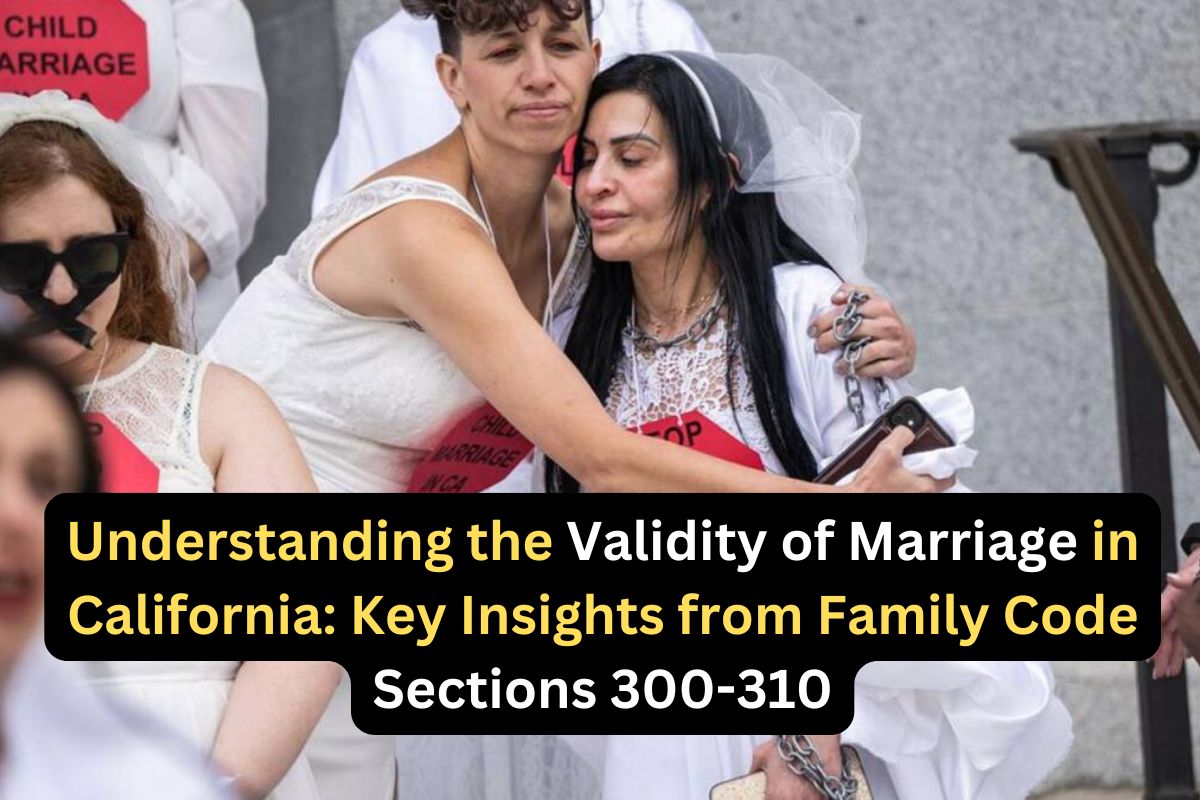Overview of California Family Code Sections 300-310
California Family Code Sections 300 through 310 address the fundamental aspects of marriage validity in California. These sections define the legal framework for determining whether a marriage is valid, outlining requirements for marriage ceremonies and the effects of legal formalities on marital status.
Key Provisions
1. Section 300: Definition and Requirements
– Text: “Marriage is a personal relation arising out of a civil contract between a man and a woman, to which the consent of the parties competent to contract is necessary.”
– Interpretation: Section 300 establishes the basic definition of marriage in California as a civil contract between a man and a woman. This section underscores the necessity of mutual consent between competent parties. “Competent” generally means individuals who are legally capable of entering into a marriage, which includes being of legal age and mentally competent.
Case Law Insight: In In re Marriage of H(S) (2003) 111 Cal.App.4th 929, the court reaffirmed that the essential requirements for a valid marriage include mutual consent and legal capacity. This case highlights that a lack of consent can invalidate a marriage, stressing the importance of both parties’ voluntary agreement.
2. Section 302: Marriage Ceremonies and Formalities
– Text: “A marriage must be solemnized by a person authorized to perform marriages, and the parties must declare, in the presence of the person solemnizing the marriage, that they take each other as husband and wife.”
– Interpretation: Section 302 mandates that marriages must be solemnized by an authorized officiant and requires the couple to declare their intent in the officiant’s presence. This formal declaration is crucial for the marriage’s validity.
Case Law Insight: In People v. Tindall (2007) 174 Cal.App.4th 303, the court addressed the issue of whether a marriage was valid when the officiant was not officially recognized. The court ruled that a marriage is invalid if the officiant is not properly authorized, emphasizing the importance of adhering to statutory requirements for solemnization.
3. Section 303: Civil Marriage License
– Text: “A marriage license shall be issued to the parties by a county clerk before the marriage is solemnized.”
– Interpretation: Section 303 requires that a marriage license be obtained from the county clerk before the marriage ceremony. The license serves as official proof that the marriage has been legally sanctioned and is a prerequisite for solemnization.
Case Law Insight: In In re Marriage of DeLuca (1986) 177 Cal.App.3d 98, the court examined the impact of an unissued marriage license on the validity of the marriage. The ruling affirmed that a marriage conducted without an issued license is not legally valid, reinforcing the importance of this document.
4. Section 304: Age and Consent
– Text: “A marriage of a person who is under the age of 18 years is not valid unless the person has obtained a court order.”
– Interpretation: This section stipulates that individuals under 18 years old require a court order to validate their marriage. This provision aims to protect minors from entering into marriage without proper judicial oversight.
Case Law Insight: People v. Riddle (2005) 130 Cal.App.4th 1158 highlights that a marriage involving a minor without a court order is invalid. The court emphasized the necessity of judicial approval to ensure the minor’s interests are protected.
5. Section 306: Proof of Marriage
– Text: “Proof of marriage is provided by the record of marriage in the office of the county clerk.”
– Interpretation: Section 306 establishes that the official record of marriage, maintained by the county clerk, is the primary evidence of a valid marriage. This record is essential for legal purposes and proves the marriage’s existence.
Case Law Insight: Gonzalez v. Gonzalez (2009) 174 Cal.App.4th 572 illustrates the reliance on official records as proof of marriage. The court ruled that discrepancies in the recorded documents could impact the recognition of marriage, underscoring the importance of accurate record-keeping.
6. Section 308: Common Law Marriage
– Text: “No common law marriage is valid in this state.”
– Interpretation: California does not recognize common law marriages. Couples must follow statutory procedures to validate their marriage, which includes obtaining a marriage license and having the marriage solemnized by an authorized officiant.
Case Law Insight: In Estate of Wright (1981) 115 Cal.App.3d 499, the court reaffirmed that California’s prohibition of common law marriages means that only marriages performed according to statutory requirements are recognized.
Conclusion
Understanding the validity of marriage under California Family Code Sections 300-310 involves comprehending the requirements for marriage definition, solemnization, licensing, age restrictions, and record-keeping. Relevant case law underscores the importance of adhering to these legal requirements to ensure a marriage’s validity. Students should carefully analyze these sections and case laws to grasp how statutory and judicial interpretations shape the validity of marriages in California.

